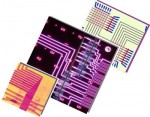Researchers from Harvard and MITRE announce world’s first programmable nanoprocessor

We’ve seen plenty of breakthroughs involving nanowires over the years, but none of those have involved an actual programmable processor — until now, that is. That particular “world’s first” was just announced by a team of researchers from Harvard University and the MITRE Corporation this week, and it’s being described as nothing short of a “quantum jump forward in the complexity and function of circuits built from the bottom up.” As for the processor itself, it consists of an array of nearly 500 germanium nanowires that have been criss-crossed with metal wires on a chip that’s just 960 micrometers (or less than 1 millimeter) square. That becomes an actual processor when the researchers run a high voltage through the metal wires and switch the individual intersections off and on at will — we’re simplyfing things a bit, but you get the idea. What’s more, the researchers note that the architecture is fully scalable, and promises to allow for the assembly of “much larger and ever more functional nanoprocessors.” Head on past the break for the official press release. [Thanks, Chris] Continue reading Researchers from Harvard and MITRE announce world’s first programmable nanoprocessor Researchers from Harvard and MITRE announce world’s first programmable nanoprocessor originally appeared on Engadget on Fri, 11 Feb 2011 19:09:00 EDT. Please see our terms for use of feeds . Permalink


Posted by
on February 11, 2011. Filed under
News,
Tech.
You can follow any responses to this entry through the
RSS 2.0.
You can leave a response or trackback to this entry

